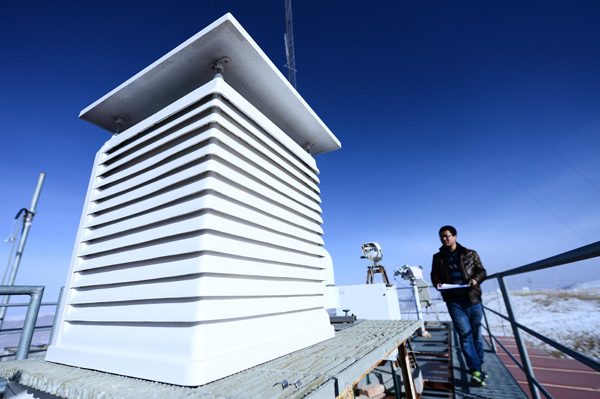
Wang Jianqiong likes to fry his food, but while at work in the China Global Atmosphere Watch Baseline Observatory, he must refrain from his favorite cooking method.
The observatory, on Mount Waliguan in Northwest China’s Qinghai province, is one of 31 global baseline observatories established by the World Meteorological Organization.
Located 3,816 meters above sea level on the Qinghai-Tibet plateau, the observatory was built 23 years ago to monitor levels of ozone and greenhouse gases.
In the station’s kitchen, there is a special smoke vent that empties out three kilometers downhill.
“Most of the food is precooked, and we simply heat it,” Wang said.
Frying is banned because it produces too much smoke, which may affect data collection at the station. “We mainly eat jiaozi (dumplings), rice and noodles,” he said.
Twenty people work at the observatory, which requires a staff of at least 10 to function properly.
“They keep an eye on data collection and maintain the equipment. We take turns and change shifts every 10 days,” said Ji Jun, a meteorological monitor.
Five of the staff members have been on expeditions to Antarctica.
“From November to April, the wind at Waliguan is very similar to that of Antarctica. It is extremely difficult to walk outside,” Ji said.
Every week, the staff collect about 1,800 milliliters of air in eight bottles, two of which are sent to the United States. The rest are sent to be studied by the China Meteorological Administration.
“This data marks China’s contribution to the development of atmospheric science. It forms the factual basis for the study of how greenhouse gases, such as carbon dioxide, affect global warming,” said Zhang Guoqing, head of the observatory.
In order to take air samples, Wang takes a bottle, places it on the ground, hits a switch and runs away.
“I have to hold my breath. It cannot be drawn into the bottle,” he said.
Besides carbon dioxide, the station monitors levels of ozone, precipitation, and radioactive substances. Every day, more than 60,000 pieces of data are collected.
“We have the best equipment and some of it is quite similar to that used in Antarctic exploration tours,” said Zhang, adding that every year they use the data they have collected to map carbon dioxide changes.
“Our graphs are almost identical to those made at the National Oceanic and Atmospheric Administration’s Hawaii Mauna Loa in the US,” he said.
The Chinese observatory’s location was chosen because of its pristine environment that is free from industrial pollution, but not too far from Xining, the provincial capital, said Zhang.
However, a smoke tower built by ethnic Tibetans for religious purposes has the observatory’s staff concerned.
“The smoke tower is only 200 meters away and I worry it may affect our data,” Zhang said.
“We need to ensure that the monitoring work remains unaffected and we obtain reliable data, but we also need to consider the religious activities. We have asked the local government for help.”


